Search this site ...
Contemporary African
Tapestry
Tapestry, by definition, is a strong textile fabric either woven or sewn with colored threads creating a picture (image) or a design (pattern).
In today’s contemporary African art world, tapestry has become a fabulous vehicle for contemporary African artists to create some of the most exciting work on (and off) the continent.
Thread art, embroidery, weaving, knotting, sewing, stitching are all terms that are easily recognized but the new dynamism comes with the nontraditional mediums, the contemporary context and imagery, the fluidity of form and structure, the oblique outline; the deconstruction and the reconstruction of what we are familiar with.
This is the new genre of Contemporary African Tapestry and Thread Art.
Below are some of the artists who are currently working in this field:
- Papa Ibra Tall b 1935, Senegal
- Rachid Koraichi b 1947, Algeria
- William Kentridge b 1955, South Africa
- Mary Ann Orr b 1958, South Africa
- Bev Butkow b 1967, South Africa
- Igshaan Adams b 1982, South Africa
- Victoria-Idongesit Udondian, b 1982, Lagos
- Athi-Patra Ruga b 1984, South Africa
- Kimathi Mafafo b 1984, South Africa
- Diedrick Brackens b 1989, Texas USA
- Troy Makaza b 1994, Zimbabwe
Modern TAPESTRY in Africa
Woven tapestries, the kind one is historically familiar with, exist in some countries in Africa where the craft has been introduced by foreign organisations endeavoring to teach a new skill and enable rural societies especially the womenfolk.
Two such workshops are Rorkes Drift and Keiskamma both found in South Africa.
Rorkes Drift, KwaZulu-Natal, SA
Set up in 1963 by a Swedish couple Ulla and Peder Gowenius who transferred their wealth of experience in print, weaving and ceramics to the local populace through their workshop, the Evangelical Lutheran Church Art and Craft Centre.
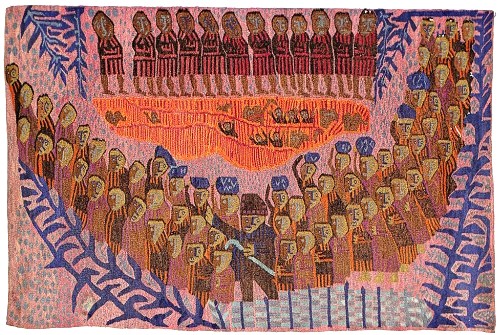 The Israelites Crossing the Red Sea by Jesse Dlamini, Miriam Ndebele & Josephina Memela
The Israelites Crossing the Red Sea by Jesse Dlamini, Miriam Ndebele & Josephina MemelaThe tapestries usually incorporated figurative images of folklore, the Bible or important events. Artistic independence and freedom of expression was encouraged and many of the artisans who were trained here turned into artists in their own right - such as Jesse Dlamini, Miriam Ndebele, Josephina Memela, Allina Ndebele and Azaria Mbatha, a male student whose designs were woven by or under the direction of his wife at Rorke's.
Allina Ndebele, South Africa
Allina started her career as a weaver at Rorke's Drift Centre, even travelling to Sweden for further training. On her return she branched out on her own to establish herself as an independent artist setting up Khumalo's Kraal Weaving Workshop in 1980. Here she pursued the representations of the oral narratives told by senior women in isi-Zulu families. Traditional themes of folklore called 'iZinganekwane' give her work meaning and impetus to her earlier experiences at Rorkes Drift.
In time she replaced this process with inspiration from her own dreams. "The Mantis Wedding" is one such piece. Her tapestries are to be found in major collections world-wide. For more on this fascinating artist who managed to establish herself against all odds and for more insight into her work, read here
Keiskamma, South Africa
Keiskamma Trust was formed in the year 2000 as a skills development project in an impoverished area of the Eastern Cape. One of their first major commissioned pieces was the Keiskamma tapestry, modeled on the Bayeux Tapestry and following it's narrative structure.
Keiskamma Tapestry
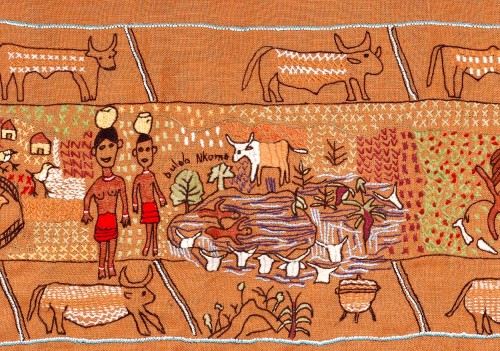 'Drowning cows', detail Keiskamma Tapestry
'Drowning cows', detail Keiskamma TapestryThe Keiskamma Tapestry, 120m in length, tells the story of the Cape Frontier from stone age San through the wars and tragedies of the Xhosa people to the peaceful resolution of the 1994 elections. This exquisitely embroidered tapestry panel represents the work of over 100 previously unemployed women from the Eastern Cape.
Today it embellishes the entrance to the South African Parliament in Cape Town, on loan from Standard Bank who purchased it for their Art Collection.
Keiskamma Guernica
In 2010 the Trust produced a tapestry the same size as Picasso's original painting of Guernica from the Spanish Civil War, (3.5m x 7.8m wide).
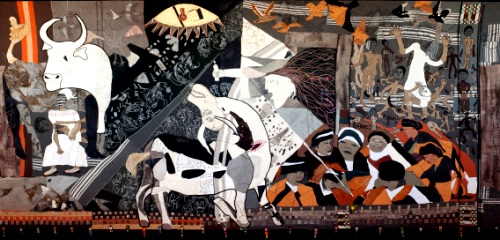 Keiskamma 'Guernica'
Keiskamma 'Guernica'The grey-brown background of the Guernica Tapestry (its sombreness resembling Picasso's monotonal use of colour) represents the grey blankets of patients receiving treatment at the Trust's Medical Centre and also the hues of traditional Xhosa skirts and hand-made felt.
Keiskamma's Guernica tells of a slower, more insidious destruction of society.. death by HIV and the gradual decline of the fraternity. Its about individual struggle and grief, about resilience and courage and the re-creation of the original Guernica helps the community express these very real emotions and realities.
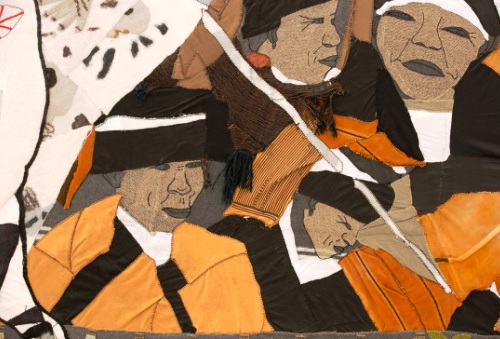 Guernica tapestry detail, 'Mourning Women'
Guernica tapestry detail, 'Mourning Women'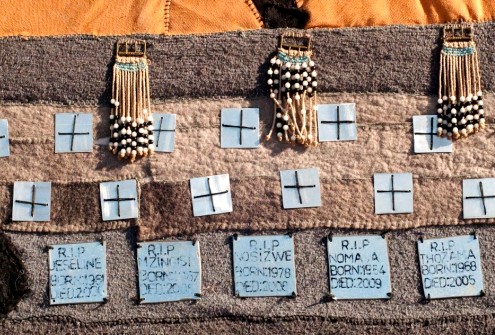 keiskamma guernica detail RIP
keiskamma guernica detail RIPThe grief of a mother is acutely shown cradling her lifeless adult child, women are gathered in mourning to mark the loss of a son and running the length of the tapestry are the names of those who died at the town's hospice... RIP.
Keiskamma Altarpiece
A project completed in 2005 but still a travelling exhibition piece is the Keiskamma Altarpiece, a collaboration of ideas and imagery from weavers and local fine art students. The vibrant and colossal altarpiece based on the Isenheim masterpiece consists of hinged panels, that open and closed, depict Xhosa life and the effects of HIV on societies in the Cape.
Incorporating dense embroidery, applique and beadwork, new techniques such as stumping were also acquired by the women weavers.
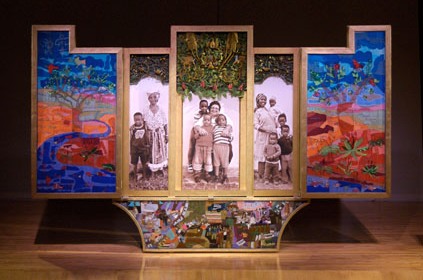 Keiskamma Altarpiece, Open Panel
Keiskamma Altarpiece, Open Panel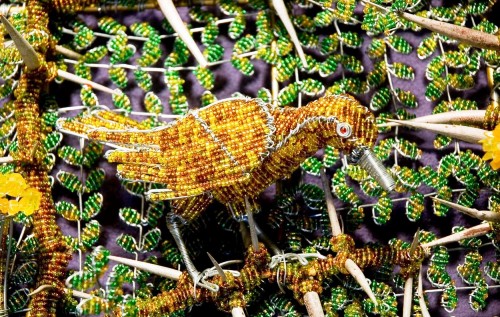 Keiskamma Altarpiece, detail, beads, stumping
Keiskamma Altarpiece, detail, beads, stumpingFully opened, the altarpiece reveals dramatic, life-size photographs of three local grandmothers and their grandchildren, some orphaned by AIDS, and their hope for the future.
Above the photographs are 3-dimensional wire bead works of indigenous Coral and Acacia trees.
Keiskamma continues to culturally engage their rural community workshop with bold and challenging projects and artists from not only the rest of South Africa but also the UK:
- The Intsikizi (Hornbill) Tapestries,
- The Botanical Series, Kirstenbosch Gardens
- The RCP Historical tapestry, London (pictorially representing 500 years)
Papa Ibra Tall (1935 - 2015) Senegal
Papa Ibra Tall was hugely instrumental in defining and constructing a new visual language for himself (and other African artists) by using African subject matter in his works.
He left Senegal in the mid 1950's to attend architectural school in Paris which he followed with a degree in Fine Arts, specialising in painting, mosaics, silk screen printing and significantly so given his future direction, tapestry.
Returning to Senegal post independence in 1960 he became head of the 'Section de Recherches Plastiques Negres' before setting up a tapestry workshop in 1966 when he joined the National Manufacture of Tapestry created by President Senghor. This became a centre for monumental tapestry production, a craft Papa Ibra Tall excelled at.
Glorious colour, local content/imagery and precision-weaving all combine to produce highly collectible classics. The large tapestries are rich in detail and pattern, often woven in wool with bright colours set against dark backgrounds making for enduring and dramatic art pieces.
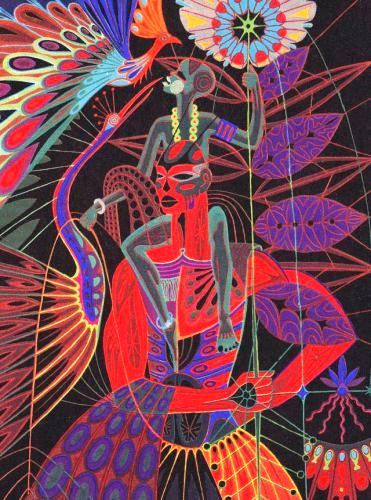 'Wonders of the bush', Papa Ibra Tall
'Wonders of the bush', Papa Ibra TallIn 1989 he became the General manager of the Senegalese Manufactures of Decorative Arts and until his death continued to play a very active role developing his own artistic process and in representing his country's artistic development.
William Kentridge, South Africa
In the last 2 decades William Kentridge has produced a collection of extraordinary tapestries in collaboration with the Marguerite Stephens Tapestry Studio in Swaziland.
Kentridge starts with a cartoon which is then interpreted by Stephens and her team, yarn by yarn, each thread a part of the whole design.
Raw skeins of mohair have been dyed and spun by the workshop. Stephens then blows up the cartoon to form a template of each tapestry which is then developed by the weavers, each making individual stitches across the grid until the final result is achieved.
The monumental scale of the images, some over 4m, still allows for sensitive interpretation with minute attention to detail and precision of line and form.
Remarkable in size and innovation, these tapestries present a fantastic medium for Kentridge's work as well as acquiring a new status for the art of tapestry in modern times.
Rachid Koraichi, Algeria
Rachid Koraichi was born in Algiers and is a multi-disciplinary artist. Tapestry is just one of his textile-based explorations. This piece above titled 'Lettre bleue a ma Mere' is part of a series dedicated to his mother and while it is based on original drawings by the artist the actual 4m high tapestry was produced in Flanders, Belgium. Always fascinated by signs and symbols, this artwork follows true to form.
Contemporary Tapestry and Thread Art
Fabric is an endless medium rich in meaning and expression even from Biblical days.
Traditionally wool or cotton or sometimes karakul, mohair and other types of animal hair were used to create tapestries and embroidery. Nowadays anything can be used including repurposed, discarded and excess materials - of, which, the careful organisation of, gives rise to new forms and new processes.
Igshaan Adams, South africa
A young man, already the recipient of many prestigious awards as well as residencies in foreign countries, this extremely creative artist from SA pushes all the boundaries not only his own artistic ones but also current societal values, all in the exploration and discovery of his talent.
A graduate of Ruth Prowse Art School in Cape Town, he has moved from wall tapestries to free form sculptures that exist beyond the constraints of a loom and to installation pieces that cover entire rooms, embracing a whole concept and creating an evocative, walk-in experience, complete with film, music and sometimes even scent.
"When Dust Settles" featuring weaving and winding, layered textures and fabric, thread and patterns on lino and "Al Latif" (Blankprojects) are two of his major installments with over 25 pieces.
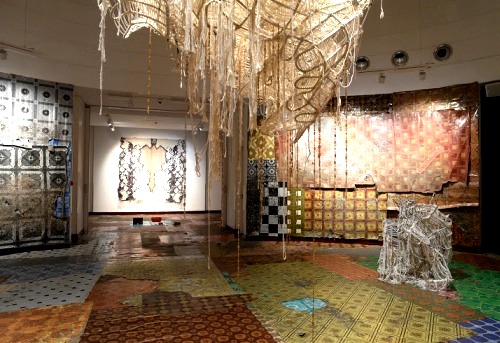 Installation, 'When Dust Settles', Standard Bank
Installation, 'When Dust Settles', Standard BankAdams is comfortable working in 3D, the tactility of the fabrics and the physicality of the structures both appeal. His floor-to-ceiling free form sculptures are a tangle of wire, thread, bead and strings. He uses string and fabric hardener to mold the fibre into a sculptural form.
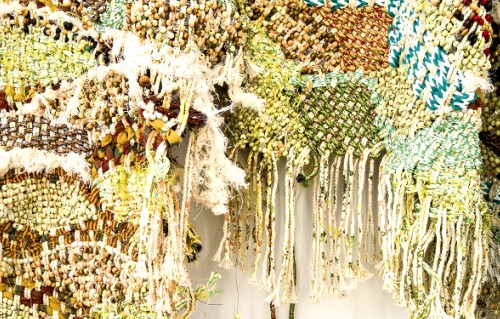 'Bent', 2018 mild steel, wire, rope, cotton offcuts, twine, beads, Igshaan Adams
'Bent', 2018 mild steel, wire, rope, cotton offcuts, twine, beads, Igshaan AdamsThe colour green often dominates the exhibition's works... representing both spiritual and natural lushness (paradise), also quietude, health and eco awareness.
The piece below is called "Groen Amara" from the Afrikaans language and translates as 'Green Amara' a potent herbal medicine.
Kimathi Mafafo, South Africa
Kimathi Mafafo is a multi-disciplinary artist working with embroidery, paint and installation pieces. Hailing from Kimberly, her works of art are far removed from the barrenness of the semi-desert environment of her youth. Lush, verdant and green they abound with flowers and luxuriousness.
The scenes in which she places her well-rounded, womanly figures are the product of a deeply imaginative mind recreating and re-imagining her body in natural surroundings but never actually representing her self.
Rather, driven by her desire to celebrate black women-hood she projects her own beliefs into the strong, beautiful female forms she portrays, albeit that they are frequently covered up in transparent cloth... like being draped in mosquito netting or wrapped in Basuto blankets. These covers are an imported device, or a prop; protection against nature but also the visibility of inner and outer self. While emphatically feminine the women are never sexualised, they appear demure and quietly contained.
Perhaps a bold statement against the female nude historically painted in the majority by men?
Mafafo works in collaboration with a Ghanaian tailor, a machine embroiderer named Mustapha Saadu. His expertise gives realisation to her vibrant imagination.
With the translation of her intricate and meticulously executed images to thread, together they have found a way to rejoice in the art of an ancient craft brought to the fore of the contemporary African art world.
Athi Patra Ruga, South Africa
Born in 1984 in Umtata, this rapidly ascending artist was included 2 years ago in the book Younger than Jesus which listed the top 500 artists in the world under the age of 33. He is the recipient of the Standard Bank Artist of the Year award and has had exhibitions all over the world including participating in the South African pavilion in Venice Biennale, 2013.
His art is manifested through textiles, video, performance, sculpture, fashion and photography.
He draws on a wide range of influences from cultural (hip-hop, Xhosa folklore) political (gender and socially based) and the complexities of modern South African life with the establishment of a black elite and all its excesses and material aspirations.
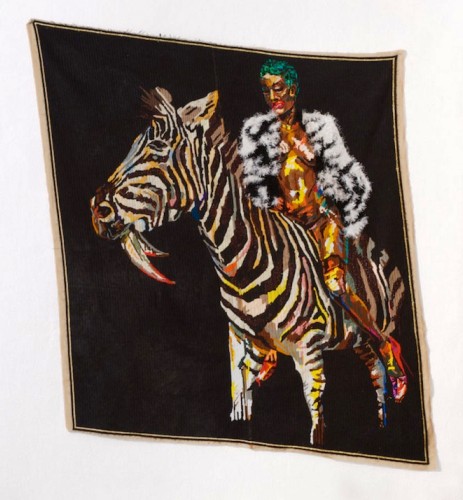 wool on canvas whatiftheworld
wool on canvas whatiftheworldHis arresting and exquisite hand-embroidered tapestries use not only traditional threads and wool but also artificial flowers, porcelain flowers, spraypaint and beads on tapestry canvas.
In October, 2018 Ruga held an exhibition in London called 'Of Gods, Rainbows and Omissions' which included works from the seriesThe Future White Women of Azania (2012 – 15) and the follow-on series Queens in Exile (2015-17).
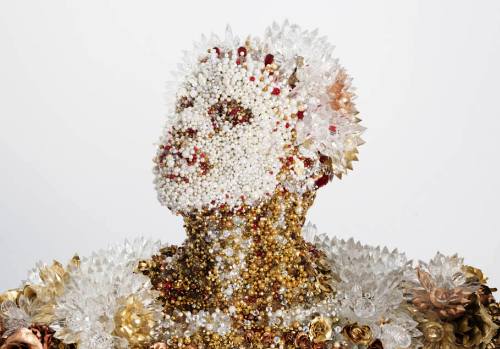 AthiPatra Ruga, 'Proposed model of dancer Francois Feral Benga' highdensity foam, artificial flowers, jewels
AthiPatra Ruga, 'Proposed model of dancer Francois Feral Benga' highdensity foam, artificial flowers, jewelsThe third component was from the ongoing series The BEATification of Feral Benga (2017-)
"Ruga’s monumental tribute to the forgotten Senegalese dancer and queer icon that explores memory, identity and embodied knowledge".
Diedrick Brackens, USA
Texas born and Los Angeles based, this young artist's practice of weaving and making textiles raises not only important sociopolitcal questions about manual labour in the history of the USA but also confronts the complextities of being black and queer in the US today.
Brackens encodes his work with allegory, symbolism and myth to convey these difficult subjects.
His preferred medium is weaving with cotton being easy to manipulate, taking up dye beautifully and has historical significance with relation to enslavement.
His figurative narratives and cosmographic abstract tapestries are first designed with a composite drawing before being translated to the loom.
Hand dyeing his yarn before beginning the piece to achieve his unique palette of shades of pink, purple and ochre is another intimate process which he enjoys as much as the self-conscious expression of melding lived-experience, identity and history.
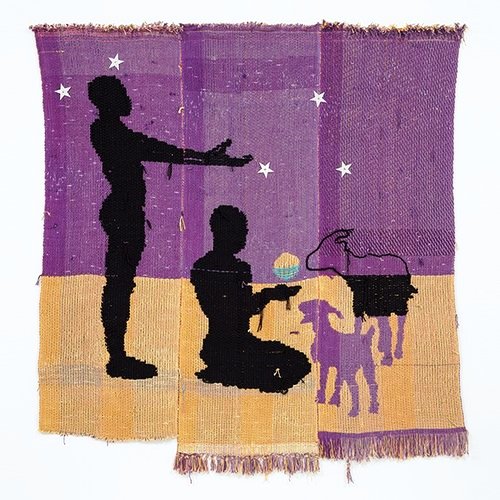 'The cup is a cloud' Diedrick Brackens
'The cup is a cloud' Diedrick BrackensHis most recent exhibition at the New Museum, New York showed large pieces drawing on the traditions of textile art; quilting in America, the richness of European tapestries and the vibrancy of West African strip weaving.
His works are literally a piecing together of histories that remain in the present.
Troy Makaza, Zimbabwe
Born in 1994 in Harare he continues to live and work in this capital city. Having studied painting nd sculpture at college he gradually extended his practice into producing daring and individual 3-dimensional pieces that employ new techniques and a new medium.
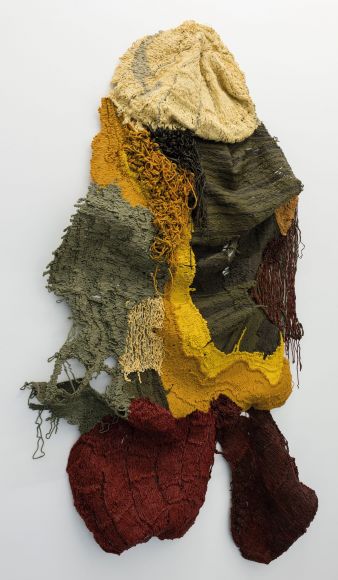 "Camo', Zeitz Mocaa, 2019
"Camo', Zeitz Mocaa, 2019His unique approach blends a diverse and vibrant range of shapes, structures and textures into contemporary tapestries that bridge a traditional art form with a modern practice.
Moving between painting and sculpture he intentionally disrupts set categories and his subject matter is equally fluid moving between abstraction and figuration.
The detail above from a tapestry at his 2019 solo show at the Zeitz Mocaa Museum in Cape Town, SA show the complex organic arrangement of his painted silicone threads into woven form.
The tactility of his material and the tangibility of the colors he has used engage the viewer immediately.. but the shapes can be read directly or not.
Bev Butkow, South Africa
Bet Butkow was born in 1967 in South Africa. An accountant by profession she is a self taught artist who specializes in a form of thread art that symbolizes her reflections on woman's issues, specifically the eternal labour of women and its invisibility within society.
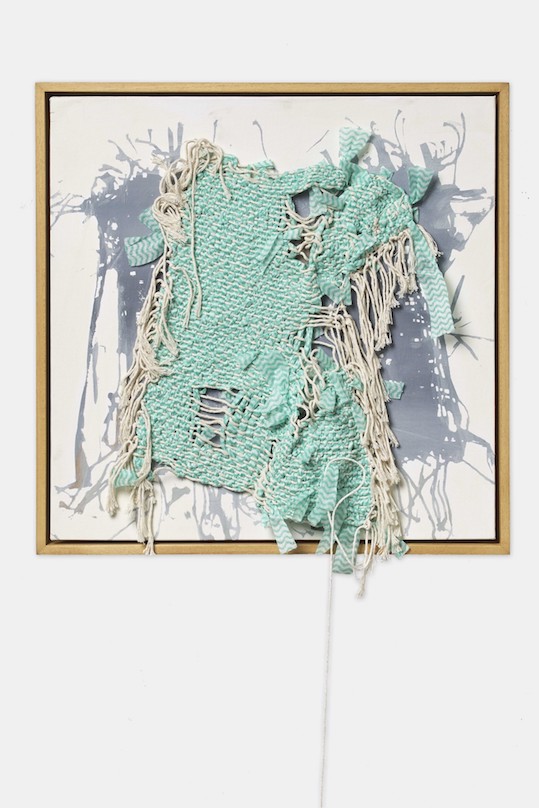 'Entanglement I'- Bet Butkow, 2019
'Entanglement I'- Bet Butkow, 2019She creates abstracted works with undefined borders; woven, painted and entangled sculptural wall pieces using all sorts of medium to portray her message: Beads, rice paper, string, repurposed material.. whatever comes into her realm and makes sense for the portrayal of her meaning.
An aspiring and inspirational contemporary African artist she is represented by Guns and Rain Gallery in SA and she is widely represented at both local and international art fairs, exhibitions and private collections.
Mary Ann Orr, South Africa
Mary Ann Orr was born in South Africa and attended Michaelis School of Art in Cape Town where she studied sculpture and drawing. Her foray into thread art was part of her life's process, an intense period in the mid 2000's that led to the construction of an extraordinary series of tapestries, some double-sided and some singular sided pieces.
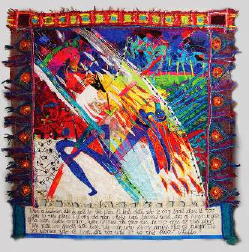 'The Veil', single side thread art, Mary Ann Orr
'The Veil', single side thread art, Mary Ann OrrHer use of materials that are found and rejected on rubbish heaps and charity bins is central to her desire to transform at all levels. The fact that she is working with fabrics and clothing items often hauled out of a bin also has a succinct comment on the charity-driven situation in the Third World. Orr takes these garments, cuts them up into tiny squares and re-invents them, transforming them from apparent nothingness into 'something-ness'.
Mary Ann Orr's double-sided thread art pieces are highly original and are unique in their method of construction where the front and back have two different reflections of the same image, doubling the rich visual experience.
These luminous, joyous fabric 'sculptures' are to be viewed from both sides; walking around them encourages the observer to participate in the journey that the artist herself has taken.
She draws deeply upon San spirituality, stating "San cosmology allows me to enrich the message of transformation and places this within a very African context". Her own profoundly personal and spiritual journey is manifested in her double-sided tapestries where the threads are drawn from front to back like the soul's journey from the before to the after-life.
Contemporary African Artists who use EMBROIDERY in their Art
- Amita Makan b Port Elizabeth, South Africa
- Ghada Amer b 1963, Cairo
- Joana Choumali b 1974, Cote D'Ivoire
- Hannelie Taute, South Africa
- Pierre Fouche, South Africa
- Sara Ouhaddou b 1986, France/Morocco
On photographs printed on canvas, on fabric and on paper.. these artists all embellish their work with thread, adding an extra surface dimension and a visual focus on areas of the piece.
Sometime its just about the nature of the thread; tangled, glittery, free-form, texture, colour , definition of shape or line, there are many reasons artists turn to this classic medium and project it into a modern form of art.
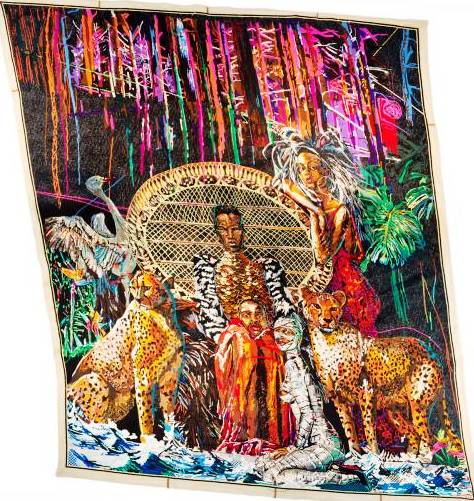
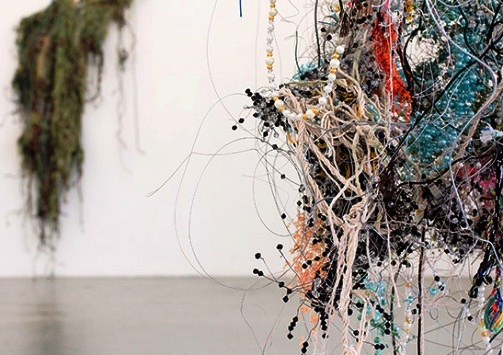
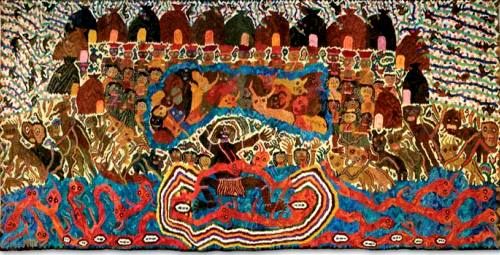
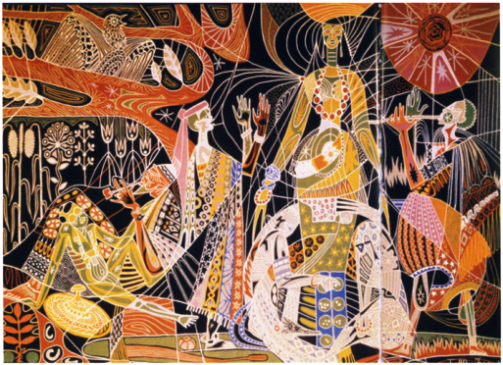
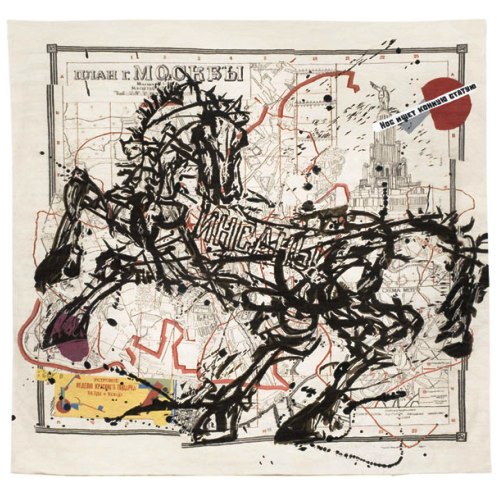
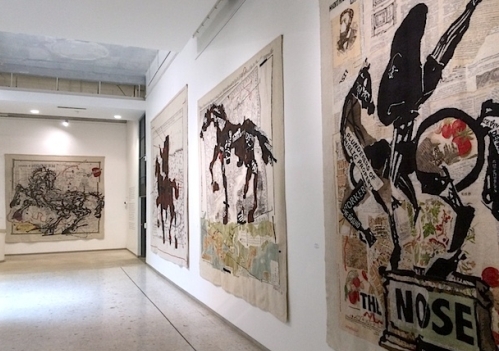
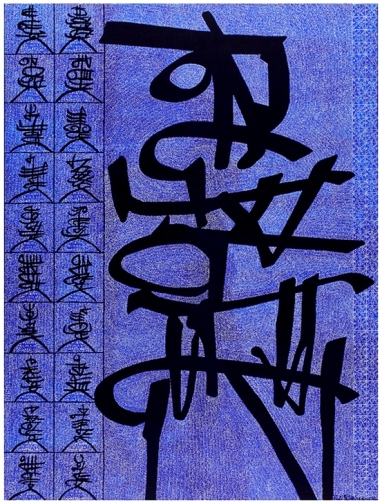
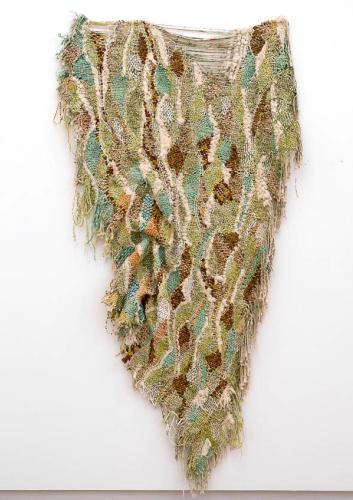
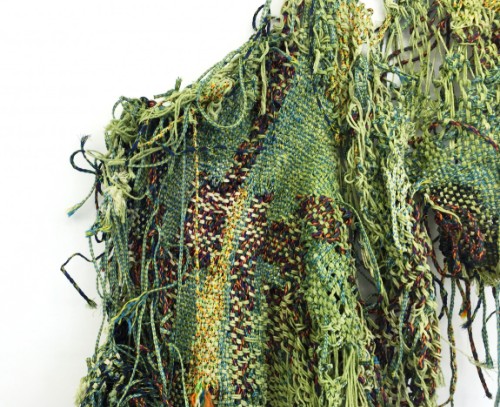
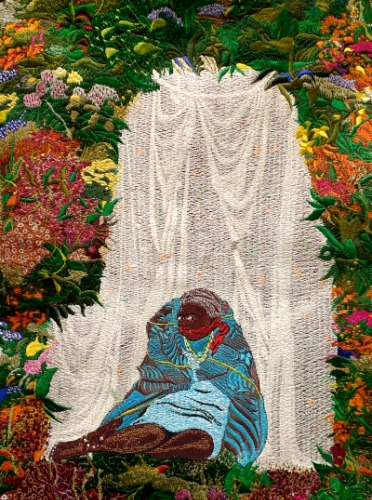
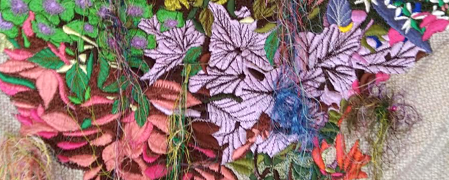
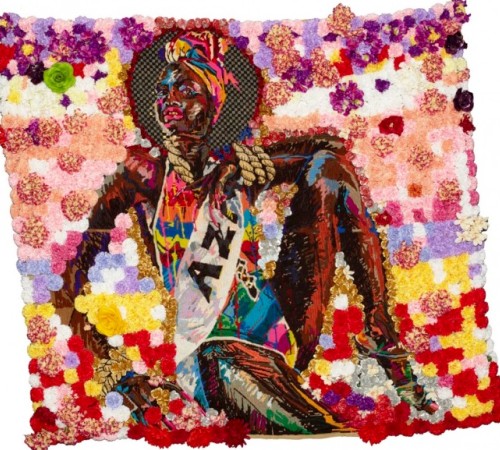
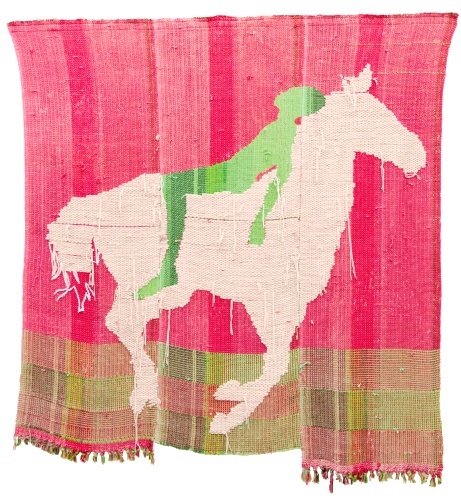
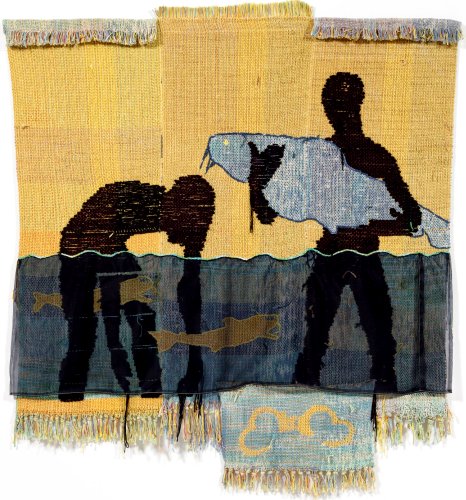
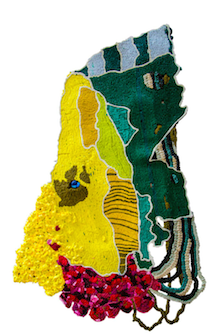
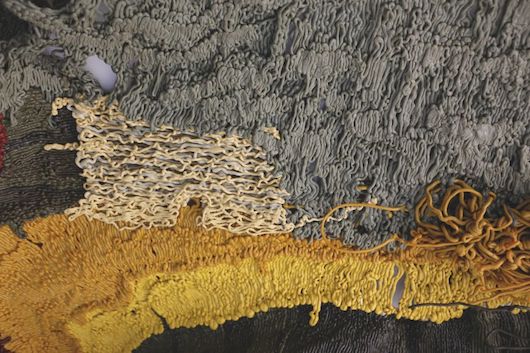
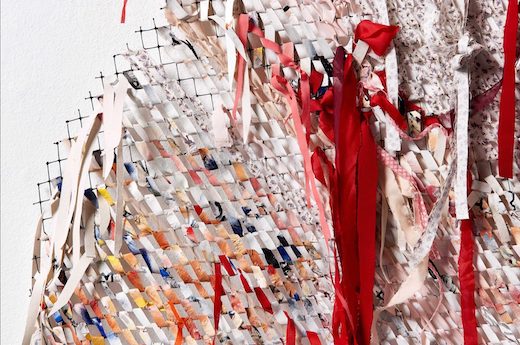
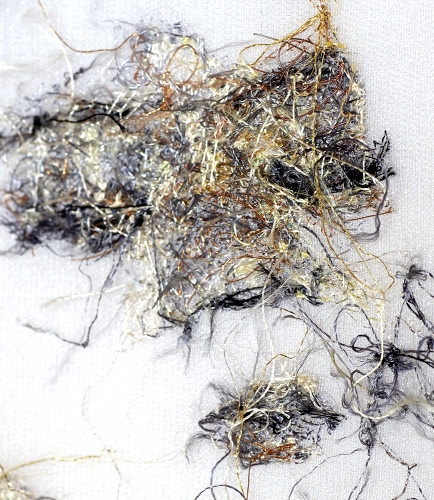
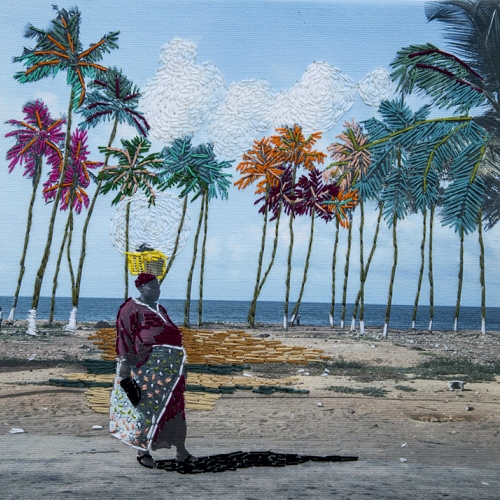
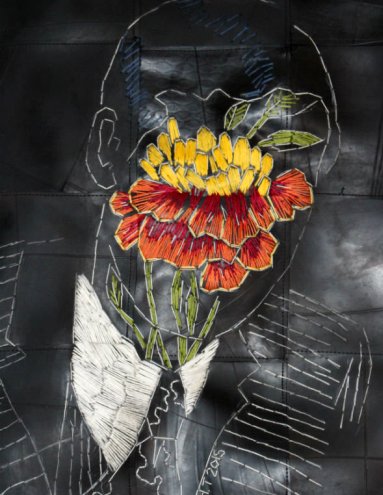
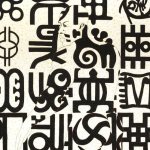
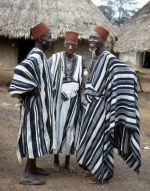
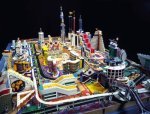
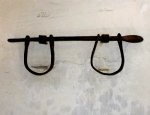
New! Comments
Have your say about what you just read! Leave me a comment in the box below.